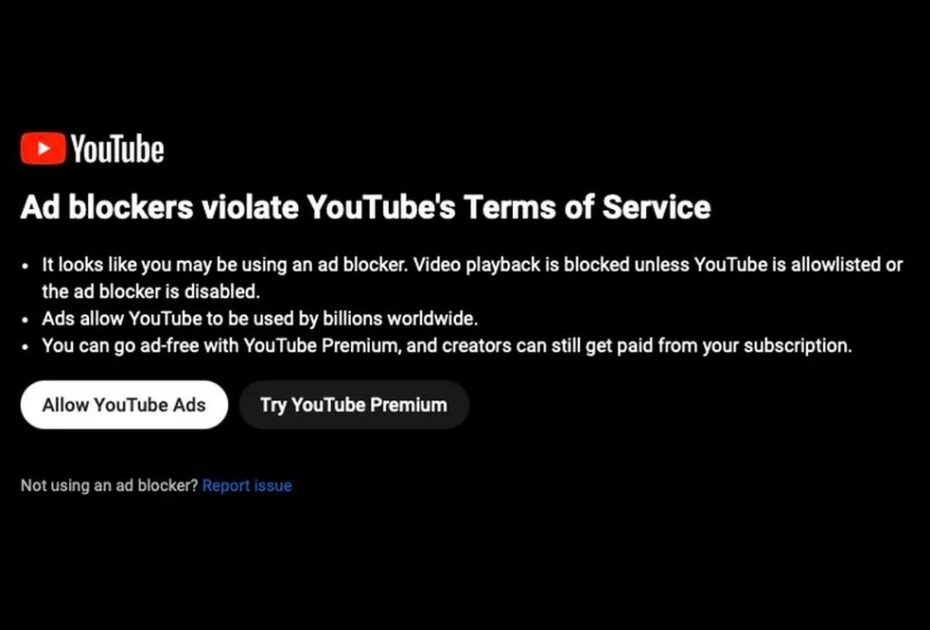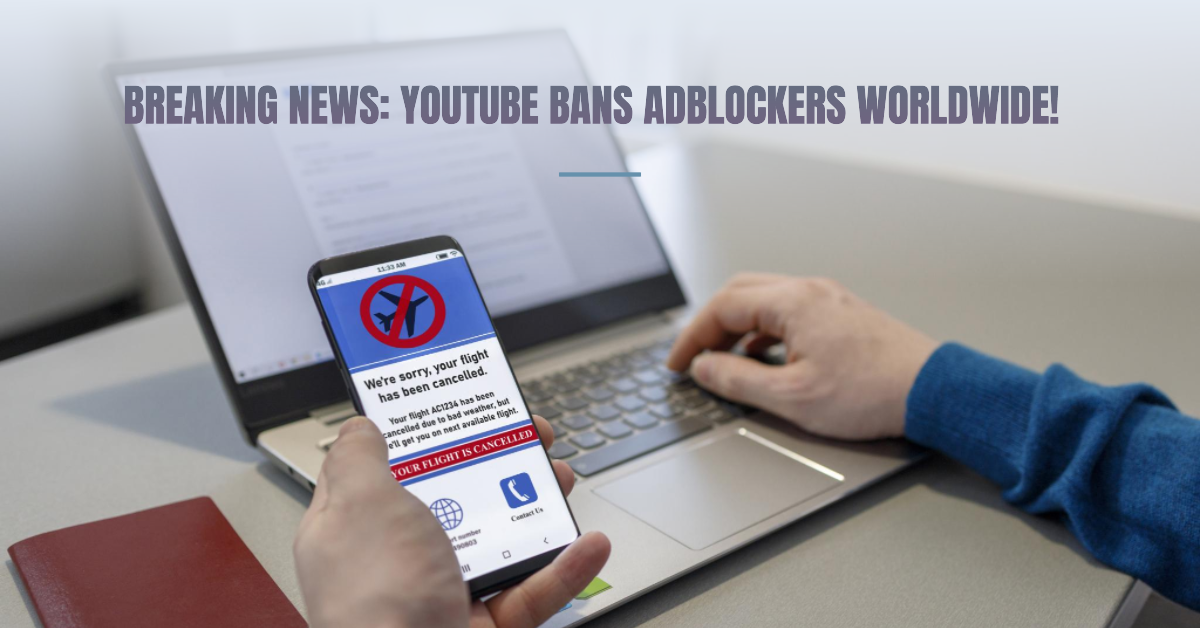In a world where online video content has become an integral part of our daily lives, YouTube stands as the behemoth of the industry, delivering a plethora of videos ranging from entertainment to education. However, YouTube Adblocker Ban with the advent of Adblocker, viewers have been granted the power to skip ads and enjoy uninterrupted content. That is until recently when a bombshell announcement sent shockwaves throughout the YouTube community – YouTube has completely banned ad blockers worldwide.
Understanding Adblockers
Adblockers, in essence, are digital tools designed to provide users with an ad-free online experience. These software or browser extensions work by detecting and neutralizing the ad scripts and elements present on web pages. When a user activates an ad blocker, it essentially hides or alters these advertisements, preventing them from displaying on the user’s screen. This leads to an uninterrupted content consumption experience, devoid of annoying pop-ups, banners, or video ads.
Adblockers are popular for several reasons. Firstly, they enhance user experience by reducing the distractions and interruptions caused by ads. This is particularly beneficial for individuals who want to focus on the content they are consuming, whether it’s a news article, a video, or a social media post. Secondly, adblockers can significantly improve page load times, as they prevent the need to fetch and display resource-heavy advertisements. Faster loading times not only save users time but also reduce data consumption, making them an attractive option for mobile device users.
However, the use of adblockers is not without its controversies. One of the most significant drawbacks is the impact on content creators, especially on platforms like YouTube.
The Pros and Cons of Using Adblockers on YouTube
On YouTube, adblockers are a double-edged sword. Users who employ these tools on the platform are thrilled with the uninterrupted viewing experience they offer. No more sitting through video ads or encountering intrusive banners. Content plays seamlessly, and there’s no need to endure those five-second countdowns. However, this convenience comes at a cost.
Content creators on YouTube rely heavily on ad revenue to sustain their channels. When users employ adblockers, the revenue generated from ads decreases or disappears entirely. This reduction in income can affect the quality of content produced, making it challenging for creators to invest time and resources in delivering engaging videos. As a result, YouTube content might not be as diverse or of the same quality without the financial support that ads provide.
The Prevalence of Adblocker Usage Globally
The usage of adblockers has witnessed a significant surge in popularity globally over the years. Millions of users have installed these tools to enhance their online experiences. Adblockers have become a symbol of control for users who want to tailor their internet usage to their preferences. This surge in popularity has been a cause for concern in the advertising industry.
The advertising industry relies on the revenue generated from online ads to fund a multitude of free content and services. This revenue supports the creation of websites, apps, and platforms, allowing users to access a plethora of information and entertainment without paying out of pocket. The widespread adoption of adblockers threatens this revenue stream, leading to discussions on how the industry should adapt to this changing landscape.
YouTube’s Initial Approach to Adblockers

YouTube’s stance on adblockers in the past was somewhat lenient. The platform recognized that adblockers could provide a better experience for users by reducing ad interruptions. While YouTube didn’t officially endorse adblockers, it didn’t aggressively prevent users from employing them either. This approach was an attempt to strike a balance between user experience and revenue generation.
Measures Taken by YouTube to Combat Adblockers
As adblocker usage continued to grow, YouTube found itself in a precarious position. The platform needed to ensure that content creators could sustain their channels while providing a positive user experience. To address this challenge, YouTube began implementing measures to counter ad-blockers. These measures included restricting access to certain features or content for users employing ad-blockers. The intention was to incentivize users to support content creators by viewing ads while still allowing a degree of ad-free viewing for those who chose not to do so.
The Impact of These Measures on Users and Content Creators
The battle between YouTube and ad-blockers created a tug of war with far-reaching consequences. Some viewers celebrated the ad-free experience they could still enjoy, while others lamented the impact on content creators. For creators, the measures taken by YouTube to combat ad-blockers were a lifeline, helping to ensure a more stable source of revenue. However, the balancing act between maintaining a healthy ad ecosystem and giving users control over their viewing experience remained a challenge, and it eventually led to YouTube’s decision to ban adblockers. This decision, while not without controversy, was a significant shift in the landscape of online advertising and content consumption.
Breaking news: YouTube’s decision to completely ban adblockers

In a sudden and drastic move, YouTube announced a complete ban on ad-blockers worldwide. This decision sent shockwaves through the online community, leaving many users and content creators in disbelief.
The reasons behind YouTube’s drastic action
YouTube cited several reasons for this decision, including the loss of revenue for content creators, a decline in ad effectiveness, and concerns about the future of online advertising.
Implications of the ban for YouTube users and creators
The ban on adblockers has far-reaching implications, affecting how users enjoy content and how content creators monetize their work. The fallout from this decision is extensive.
The Reaction from the Tech Community
Tech experts’ opinions on YouTube’s decision
Tech experts and commentators weighed in on YouTube’s bold move, offering a variety of opinions on the ban’s implications, legality, and consequences for the online landscape.
Alternative solutions for adblocker users
In response to the ban, tech enthusiasts and developers began to explore alternative solutions, seeking ways to bypass the restrictions and continue enjoying ad-free content.
Possible legal challenges to YouTube’s ban
The ban on adblockers raised questions about the legal aspects of online advertising and the rights of users to control their online experience. Legal challenges to YouTube’s decision were not ruled out.
Impact on Advertisers
Advertisers’ perspective on adblockers and YouTube’s ban
Advertisers, who rely on YouTube as a significant advertising platform, had mixed feelings about the ban. Some saw it as an opportunity to reach a more engaged audience, while others worried about the potential decline in ad viewership.
The effectiveness of YouTube ads after the ban
With adblockers out of the equation, YouTube ads had the potential to become more prominent and reach a wider audience. Advertisers closely monitored the effectiveness of their campaigns.
Strategies for advertisers to adapt to the changes
Advertisers began to devise new strategies to navigate the post-adblocker era on YouTube, focusing on creating compelling ads that would engage users and maximize their reach.
Benefits and Losses of YouTube’s Adblocker Ban
YouTube’s decision to completely ban adblockers worldwide has stirred a significant amount of debate and discussion. This move by the video-sharing giant has both advantages and disadvantages, impacting various stakeholders, including users, content creators, and advertisers. Let’s delve into the details of these benefits and losses:
Benefits:
1. Increased Revenue for Content Creators:
- Content creators on YouTube primarily generate revenue through advertisements. The ban on adblockers means that more viewers will be exposed to ads, leading to higher ad revenue for creators. This can incentivize content creators to continue producing quality content.
2. Better Ad Effectiveness:
- Advertisers can benefit from improved ad effectiveness. With adblockers out of the picture, ads have a higher chance of reaching the intended audience, resulting in more successful ad campaigns.
3. Enhanced User Engagement:
- Users who were accustomed to bypassing ads using adblockers are now more likely to engage with ads. They may click on links, make purchases, or interact with ad campaigns, providing advertisers with valuable user engagement.
4. Innovation in Online Advertising:
- The ban has triggered innovations in online advertising. Advertisers are exploring more engaging and interactive ad formats, improved targeting technologies, and creating ads that users find valuable and relevant.
5. Balanced User Experience:
- YouTube aims to strike a balance between ad-free and ad-supported content. While some users prefer an ad-free experience, others understand that ads are necessary for content creators to continue producing quality content.
I hope you find this article informative and useful. Thank you for your interest in trying it out.Top Picks for This Week OTT Release Movies and Series Oct 27, 2023 in my previous post. 😊
Losses:
1. User Disruption and Annoyance:
- Users who relied on adblockers to enjoy ad-free content on YouTube may now be disrupted and annoyed by ads. For some, this change can lead to a less enjoyable viewing experience.
2. Privacy Concerns:
- The ban raises privacy concerns as online ads often rely on user data for targeting. Users may feel their privacy is compromised, as ads become more personalized without the protection of adblockers.
3. User Migration to Alternative Platforms:
- Some users dissatisfied with YouTube’s ad policy may migrate to alternative platforms that offer ad-free content. This migration can result in a loss of viewership for YouTube and its content creators.
4. Viewer Backlash:
- Content creators could face viewer backlash due to the sudden introduction of ads. Viewers who were used to ad-free content may express their displeasure, affecting content creators’ reputations and viewer loyalty.
5. Ad Overload:
- There is a risk of ad overload on YouTube. With no adblockers to limit the number of ads, viewers may experience an excessive number of ads before and during videos, potentially driving some users away.
6. Challenges for Smaller Creators:
- Smaller content creators, who may not have a substantial following, may struggle to adapt to the adblocker ban. They might not experience the same revenue increase as larger creators.
7. User-Content Creator Trust:
- The ban has the potential to erode trust between users and content creators. Users may feel that content creators are prioritizing ad revenue over the quality of their content, impacting viewer loyalty.
8. Viewer Reactions and Feedback:
- YouTube may receive negative feedback and criticism from viewers, which could influence the platform’s decision-making and necessitate adjustments.
In conclusion, the ban on adblockers on YouTube has both benefits and losses, and the impact varies among users, content creators, and advertisers. The long-term effects of this decision will continue to shape the online advertising and content consumption landscape, as YouTube and its stakeholders adapt to the changing environment.
User Reactions
User feedback on social media and forums
As the ban on adblockers took effect, users flocked to social media and online forums to express their opinions, concerns, and frustrations regarding the changes.
How users are coping with the absence of adblockers
Users who were accustomed to adblockers were forced to adapt to the new YouTube environment. Some embraced the change, while others sought alternative platforms for ad-free content.
Complaints and concerns raised by the YouTube community
The YouTube community didn’t hold back when it came to expressing their complaints and concerns. The impact on user experience and content creators was at the forefront of these discussions.
Content Creators and Their Dilemma
The views of YouTube content creators on the adblocker ban
Content creators, the backbone of YouTube, faced a dilemma with the ban. Some celebrated the potential for increased revenue, while others worried about alienating viewers.
How the ban affects content creation and monetization
With ad revenue playing a significant role in content monetization, the ban on adblockers had the potential to reshape how content creators approached their work and income.
The search for new revenue streams
In response to the ban, content creators explored alternative revenue streams, such as merchandise, sponsorships, and fan donations, to compensate for potential losses in ad revenue.
YouTube’s Response to Criticism
YouTube’s official statements on the adblocker ban
YouTube addressed the criticisms and concerns raised by users and content creators through official statements, providing insights into their long-term vision for the platform.
Any updates or adjustments made in response to feedback
YouTube’s response to user feedback and criticism was closely monitored. Any updates or adjustments made in the wake of the adblocker ban were subject to scrutiny.
The long-term vision of YouTube regarding adblockers
As YouTube adapted to the changing landscape, the platform’s long-term vision for adblockers and online advertising became a topic of discussion and speculation.
Alternatives for Ad-Free YouTube
Other platforms where users can enjoy ad-free content
With YouTube’s adblocker ban in place, users began exploring other platforms that offered ad-free content, raising questions about the competition YouTube faced.
Comparing the user experience on these platforms
Users started to compare their experiences on YouTube’s competitors, evaluating factors such as content variety, user interface, and the presence of ads.
The competition between YouTube and its alternatives
As users diversified their online video consumption, the competition between YouTube and alternative platforms intensified. Each platform sought to offer a unique value proposition.
The Role of Regulation
The role of government regulations in online advertising
The ban on adblockers raised questions about the role of government regulations in the online advertising industry, sparking debates about consumer rights and business practices.
Potential government interventions in the YouTube adblocker ban
Governments and regulatory bodies began to consider possible interventions to ensure a fair and balanced online advertising landscape.
Balancing user interests, content creators, and advertisers
The challenge of balancing user interests, the livelihood of content creators, and the needs of advertisers became a central theme in discussions about online advertising.
Predictions and Speculations
The future of adblockers and YouTube’s stance
Experts and commentators offered their predictions on the future of adblockers and YouTube’s approach to online advertising, considering evolving user preferences and industry trends.
Speculations on the evolution of online advertising
Speculations emerged about the broader evolution of online advertising, from the types of ads used to the platforms where they are delivered.
The impact of this decision on the tech industry as a whole
The ban on adblockers sent ripples through the tech industry, with implications for other software, platforms, and businesses related to online advertising.
Conclusion
In conclusion, the complete ban on adblockers by YouTube has ushered in a new era for online advertising and content consumption. The implications of this decision are vast and continue to shape the landscape of the digital world. As the YouTube community adapts to the changes, the debate on user experience, content monetization, and the role of regulation in online advertising persists.
Frequently Asked Questions (FAQs)

- How can viewers enjoy an ad-free experience on YouTube after the Adblocker ban? Viewers can opt for a premium subscription service like YouTube Premium. This subscription not only removes ads but also offers additional benefits such as offline downloads and access to exclusive content. It’s a hassle-free way to enjoy YouTube without ads.
- What are the alternatives for content creators to sustain their income without ad revenue? Content creators are exploring several alternatives to sustain their income without relying solely on ad revenue. Some popular options include sponsored content, merchandise sales, crowdfunding through platforms like Patreon, and offering premium subscriptions with exclusive perks to their most dedicated fans.
- What countermeasures has YouTube implemented to tackle Adblockers? YouTube has implemented various technical countermeasures to address the Adblocker issue. While the specifics are not publicly disclosed, these countermeasures involve identifying and circumventing Adblockers to ensure that creators can continue to earn revenue from advertisements.
- How will the Adblocker ban impact the advertising industry as a whole? The Adblocker ban on YouTube is a significant development that reflects broader changes in the advertising industry. Marketers will need to shift their strategies towards more native advertising, content integration, and interactive formats to engage viewers effectively. This ban encourages the industry to become more innovative and less reliant on traditional ad formats.
- What kind of viewer feedback is YouTube expecting following this decision? YouTube is likely to receive a wide range of feedback from viewers. Some may welcome the ad-free experience, while others might express concerns about the new advertising model. Feedback on premium subscriptions, content quality, and pricing will be valuable in shaping YouTube’s approach in the post-Adblocker era. YouTube is keen on listening to its community to make informed decisions.
I hope you find this article useful and informative. Thank you for your interest in checking out iQOO 12: A Powerful Smartphone with FaImpressive Features in my previous post. 😊

